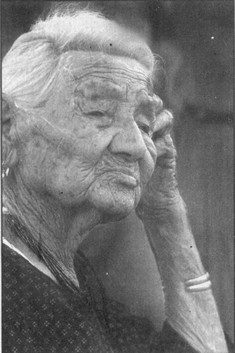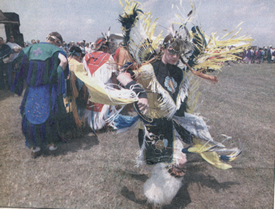|

<<<Kickapoo pic>>> |
Kickapoo Homecoming in Central Illinois |
Adapted from The Pantagraph (Bloomington, IL), May 31, 1998
|
 |
Her hair the color of winter's snow, her skin the color of earth, Salazar had traveled from Mexico to be with her people as they danced for the first time in 166 years on land where her grandfather, Neepaha, and her grandmother, Kelkowah, had lived.
"All our grandmothers lived here," said Salazar through an interpreter. "I feel good over it, that I can be around where my ancestors once roamed." |
This weekend's Homecoming Powwow of the Kickapoo Nation, which continues
today, is the first time representatives of the three recognized
Kickapoo factions have gathered since the Kickapoo tribe splintered
in 1832 when pressure from white settlers forced them to abandon
the Grand Village and move west.
As many as 3,000 people once lived there, according to a surveyor
who visited in the early 1800s. He estimated the site held about
5,000 graves, a sign the tribe lived there many years.
The Kickapoo were known as the "Kiwigapawa," or "He
Who Moves About," when they ranged over about 10 million acres
comprising three-quarters of what is now the state of Illinois.
They now occupy reservations of a few thousand acres in Oklahoma,
Texas and Kansas. Kickapoo also live in two places along the Mexican
border.
"The importance of this land is that we as a Kickapoo people
remember who we are, where we came from and how we were forced to
give up this beautiful land," said Kendall Scott, chairman
of the Kickapoo Tribe of Oklahoma. "It is of most importance
that the people who live here today in this area know that this
land once was lived on by Kickapoo people. In being here today,
we show respect for our ancestors. Their legacy, our blood, is why
this land is so important to us today and for generations to come."
"We know today that the spirits of our ancestors look down
on us and hear us and see us in our nation's regalia," added
master of ceremonies Orval Kirk as he looked out on the dancers,
many with painted faces and wearing traditional tribal dress adorned
with eagle feathers, bells and beads.
Kickapoo leadership said they were moved by the turnout for the
powwow, not only of their own people but also the non-Indians who
came to welcome them home.
"I am glad this happened. It's 170 some odd years overdue,"
said John Kaskaske, a former chairman of the Kickapoo Tribe of Oklahoma.
"I think it's great for the community to give us this support
and for the Kickapoo who have come from a long, long way to be here.
Hopefully, this will be the beginning of a new epic for our tribe."
Kaskaske said discussions are planned to see if the powwow will
be designated an annual event.
The powwow is co-sponsored by McLean County Board Member Bill Emmett
and his wife, Doris, who own about half the original site, and Midwest
Soarring, an organization dedicated to preservation of traditional
American Indian culture and burial sites.
Committed to the protection of the area, the village once occupied
and protection of the graves, the Emmetts donated an acre of the
land for a permanent park to honor the tribe. Native plants with
sacred meaning to the Kickapoo, such as sage and sweet grass, which
were common when the tribe lived there, are being replanted at the
site.
Glenn Barnhill of Normal was a traditional male dancer at this powwow. A member of the Lakota Nation, he moved here seven years ago from South Dakota |
In
keeping with the American Indian tradition of marking special
occasions with feasting and giving gifts, volunteers hosted
tribal
members Saturday night for a dinner of elk, buffalo and wild
turkey. In turn, the Kickapoo gave the Emmetts traditional Kickapoo
clothing
and made them honorary Kickapoos. For the spectators, the Kickapoo
performed a series of dances, including the war dance and the
friendship
dance, never before done in public.
"It's probably, in my opinion, the most important (American
Indian) cultural event in our state since they (The Kickapoo) left,"
said Joseph "Standing Bear" Schranz, a White Earth
Objibwa and president of the all-volunteer Midwest SOARRING.
"My heart was touched by the look in the people's eyes to know
they have reached their home again and to know that the children
are seeing that," Schranz said. "But, it's not looking
through one eye and seeing only one tribe. We are trying to see
the whole view and bring all the tribes back together. ... The common
thread is respect for the Creator and respect for the earth and
respect for our families."
If the powwow does become a yearly get-together, Salazar said her
"heart is heavy," thinking that she may not live long
enough to return to the Grand Village once more.
"I may be gone," Salazar said. "But, I will be looking
down on this arena."
The Homecoming of the Kickapoo Nation Powwow continues from 11 a.m.
to 5 p.m. today with a Grand Entry at 1 p.m. American Indian art
is for sale and there are food vendors. Entrance fee is $5 for adults,
$3 for seniors and children aged 7 and older, children 6 and under
free. No drugs or alcohol are allowed.
| This pictures shows just a few of the thousands who braved the summer heat to attend the event. |  |
To visit the old Kickapoo village and powwow grounds, travel to the LeRoy exit off Interstate 74. Drive through LeRoy to School Street, go right about five miles to McLean County Road 3100 East, then left. The site is on County Road 3100 East just north of County Road 750 North.
Section:
NEWS
Page: A1
Source: SCOTT RICHARDSON
| |
Department
of Anthropology |
copyright ©
2002 University of Illinois, All rights reserved. |

